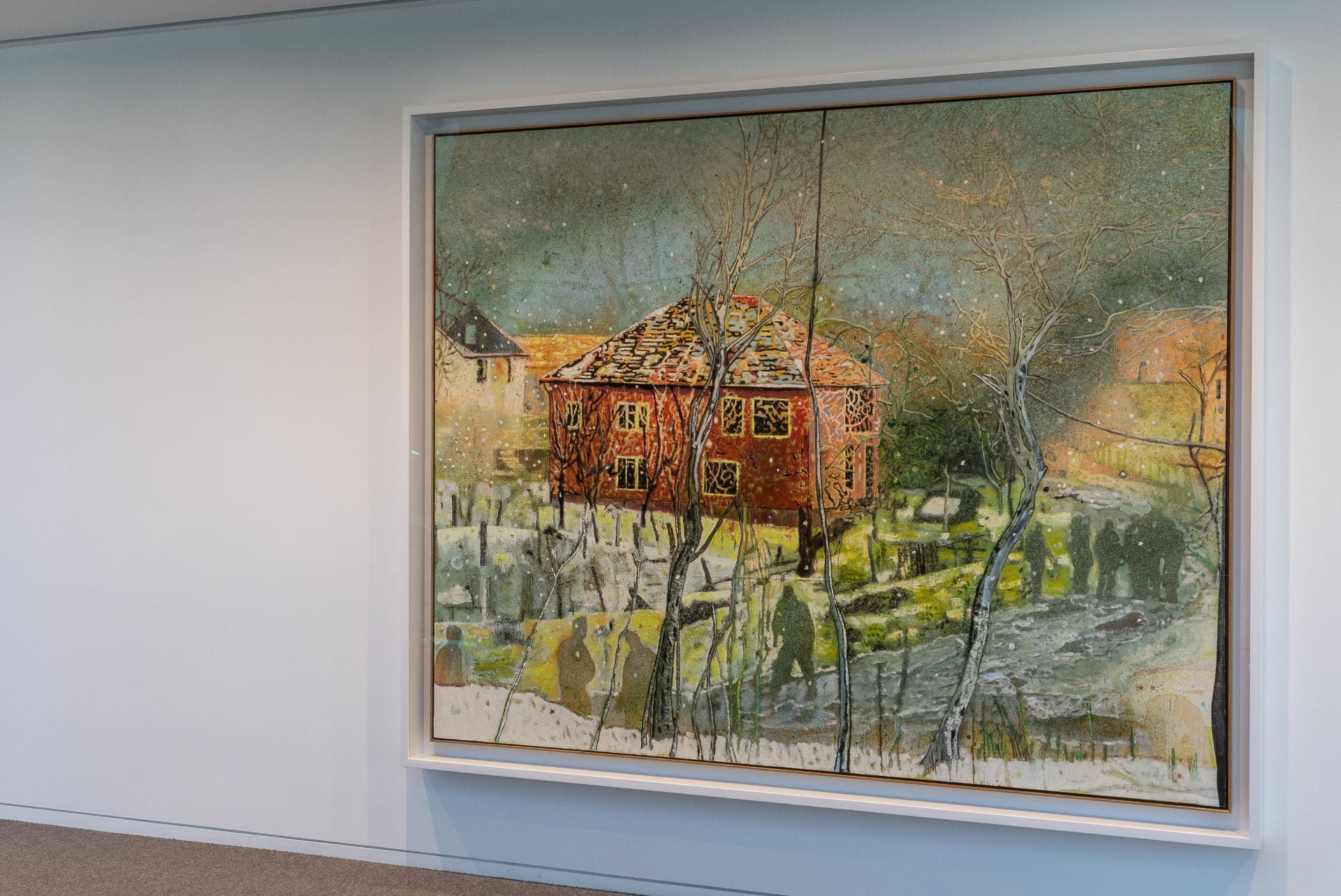
Peter Doig, Red House (1995-96)
© Peter Doig. All Rights Reserved, DACS 2021
Written by Zahra Nasser, BA in Art History and Philosophy, 2022 in collaboration with Brandon Truett, PhD ‘20
Red House (1995-6) appeared in Peter Doig’s landmark 1998 exhibition Blizzard Seventy-Seven at the Kunsthalle Düsseldorf in Germany. The show was based on Doig’s childhood memories of the infamous blizzard of 1977 that swept through New York and Ontario. Many of Doig’s artworks follow a similar narrative, finding their subject matter in moments from his life lived in Canada, the United Kingdom, and Trinidad. While Red House clearly depicts a wintry landscape, the painting features unexpected moments of warmth; the snow and amber lights glimmer on the surface of ambiguous figures that may or may not hail from the artist’s life, cultural references, or imagination. Most likely, it’s a combination of all three.
“I often paint scenes with snow because snow somehow has this effect of drawing you inwards,” Doig said in an interview in 1994. Red House is one of numerous works made around that time depicting snowy scenes which are suspended between abstraction and found imagery from photographs. Evocative of memories, but not necessarily of a specific memory, the artist draws the viewer into the experience through personal reflection. At first, Red House appears quite humble in its materiality and depictions; a bright red, brick home glows out of a wintry environment, colored by light grays, pale blues, and bare branches which appear to crack the canvas. More subtle layers emerge and divide the work into a series of layers, replicating the physical cadence of snowy and grassy hills. In the background, lime green grass clashes with more snow, suggesting spring’s imminent arrival; the human shadows seem engaged in a similar journey of progression, though it is hard to know where exactly they are headed. This haziness exemplifies the mimetic modes of Doig’s mastery, making Red House—like many of the artist’s paintings—a memory of a scene instead of the scene itself.
Read More
Artist Profile

Peter Doig
Scottish, born 1959
photo by Eva Vermandel
Written by Zahra Nasser, BA in Art History and Philosophy, 2022 in collaboration with Brandon Truett, PhD ‘20
Peter Doig has devoted his career to depicting landscapes steeped with the history and memory of places. Understanding the nomadic nature of his life provides a backdrop for understanding his work. Born in Edinburgh, Scotland in 1959, Doig moved to Trinidad briefly and spent most of his childhood in Canada. He studied in London in the early 1980s, and again later in the decade, he then spent a few years in Montreal. He returned to London once again for several years, before moving back to Trinidad in 2002.
In a 2017 interview for his No Foreign Lands exhibition, Doig elaborates on the autobiographical references in his practice, “There exists a tension,” Doig explains, “…between the often generic representation of a pastoral scene and the investment in my own experiences of the landscape. All of the paintings have an element of autobiography in them, but I resist making the autobiographical readings overly specific.”
Today, he lives between Trinidad, London and New York, and is a professor at the esteemed arts academy, Kunstakademie Düsseldorf in Germany. Doig has proved an influential and enthusiastic teacher at the Kunstakademie, traces of his approach are apparent in a diverse group of contemporary artists. In a 2013 interview with Christie’s, his modesty conceals his status as one of the most influential painters alive today, “Conversations that you have in the studio with the students are the types of conversations you don’t ever have elsewhere, really, I get a lot out of it myself, my paintings have changed quite a lot, and I have actually learnt a lot from observing the way people make things, and from talking about it.’
Related Links
No Foreign Lands (2017)
